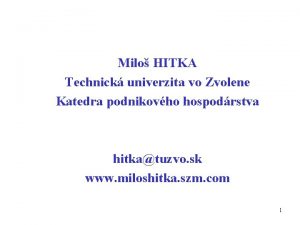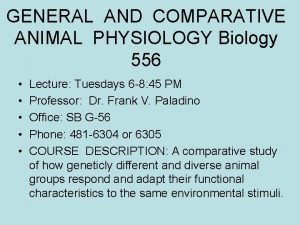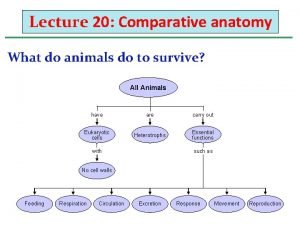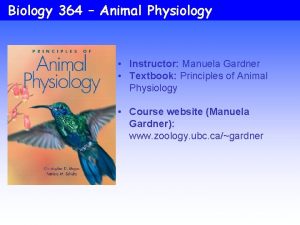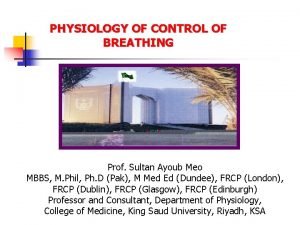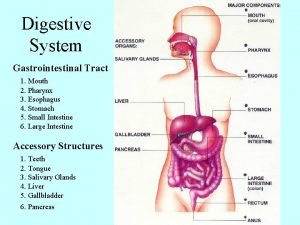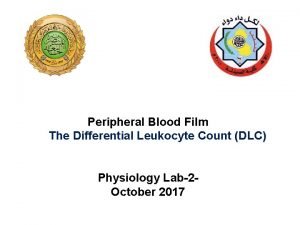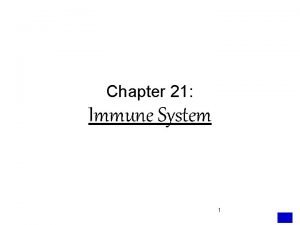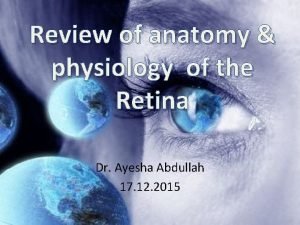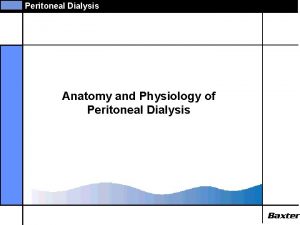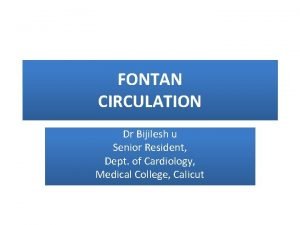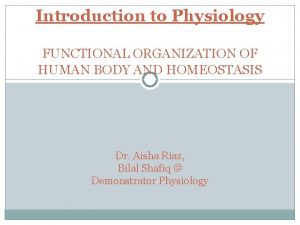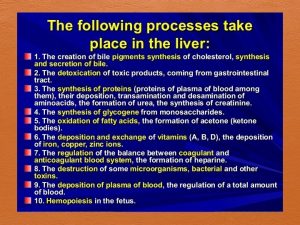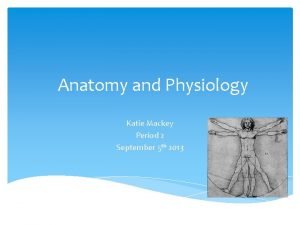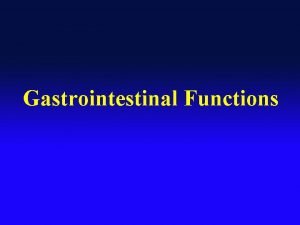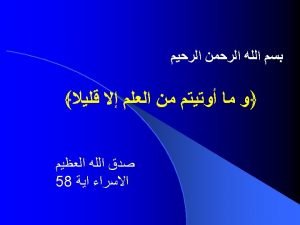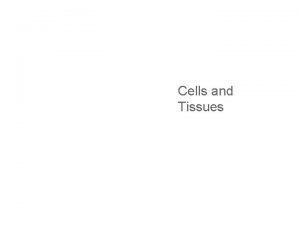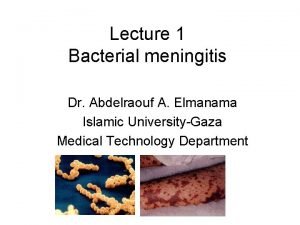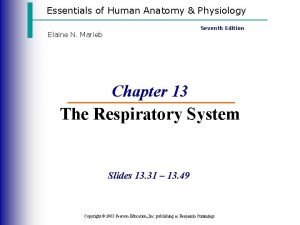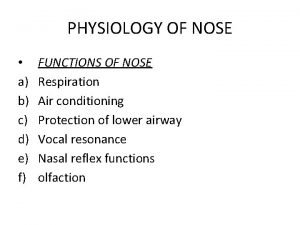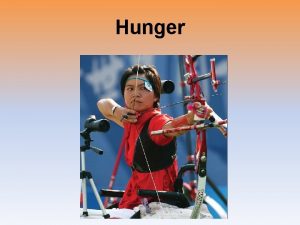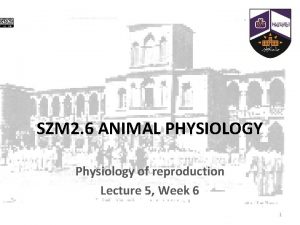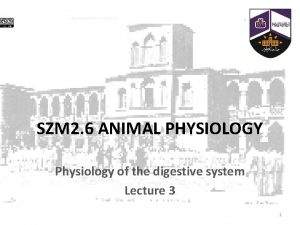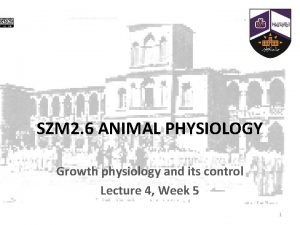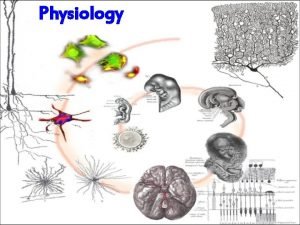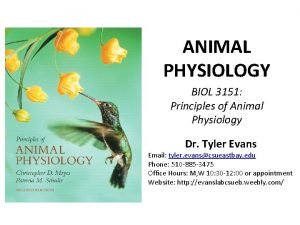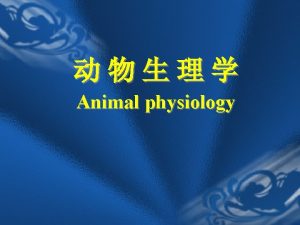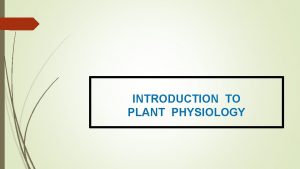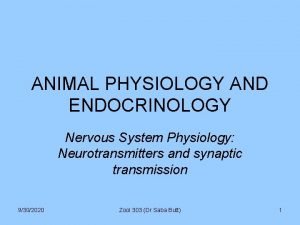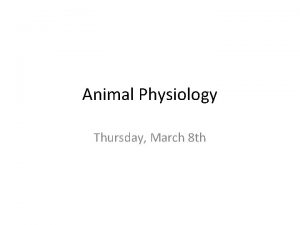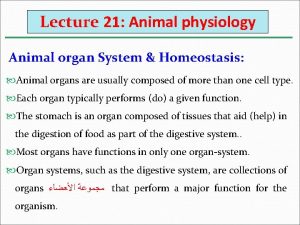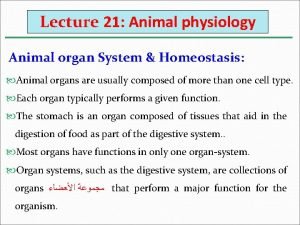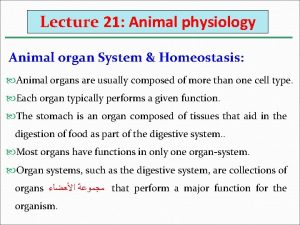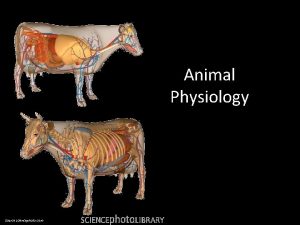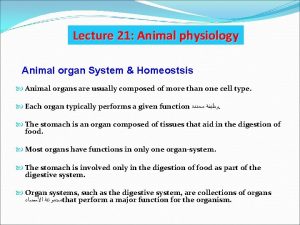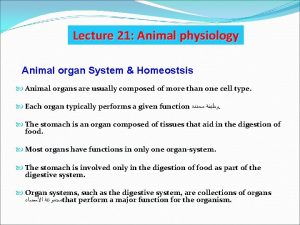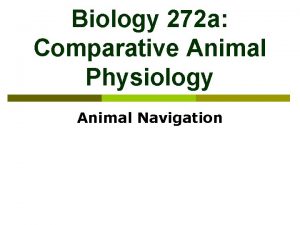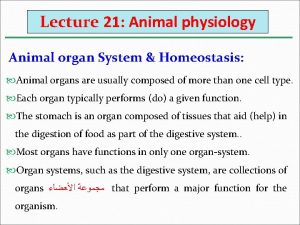SZM 2 6 Animal Physiology SZM 2 6










































- Slides: 42

SZM 2. 6 Animal Physiology SZM 2. 6 ANIMAL PHYSIOLOGY by Rania M. H. Baleelais licensed under a Creative Commons Attribution-Non. Commercial-Share. Alike 3. 0 Unported 1 License.

Information Time: Sundays from 9 -11 am Venue: Botany Lecture Room (BLR) Facilitator : Dr. Rania M. H. Baleela Lectures and reading can be found as a complementary at: http: //lms. uofk. edu/course/view. php? id=1080§io n=1 • Poor attendance will result in poor performance • Supporting references: 1. Animal physiology. Sinauer Associates Inc. Hill, Wyse and Anderson 2004. 2. Physiology of 2 small and large animals. Ruckebursch et al. • •

Evaluation and assessment • • 1. 2. 3. • = 100 marks Physiology exam evaluation: Continuous assessment during course (20 marks) Exam 80 marks (70% theory and 30% practical) Exam will contain questions from: Lectures Reading material Others The final exams may consist of multiple-choice questions (MCQ), short-answer, True and False questions, crosswords questions and mix and match questions, etc. 3

Syllabus headlines 1. Brief Introduction 2. Acclimatization (aka acclimatisation; acclimation) 3. Growth & its control 4. Digestive system 5. Reproduction 4

Week 1 Introduction 5

This week contents Introduction and definitions: I. Animal cell membrane II. Transport across the cell membrane III. Homeostasis IV. Homeostasis communication transfer 6

Physiology = Study of function (Greek) “Principles of physiology are universal” e. g. what is learned about the physiology of yeast cells can apply to human cells 7

Physiology= Study of function=How & why 1. How questions: • address the mechanism by which a process (e. g. , digestion) occurs. 2. Why questions: • address the underlying ecological, behavioural & mechanistic reasons for why a structure or behaviour exists. • Examples • How does the vertebrate heart function? • How do muscle fibres produce power? • Why do seals dive for longer periods than they can sustain aerobically? 8

I. Cell Membrane Structure From http: //www. cbv. ns. ca/bec/science/cell/fluid_mosaic. jpg Fig 1 FLUID MOSAIC MODEL FLUID- individual phospholipids & proteins can move around freely within the layer. MOSAIC- the pattern produced by the scattered protein molecules when viewed from above. 9

1. Phospholipids • Chemically diverse e. g. human RBCs contain >150 different chemical forms of phospholoipids e. g. Fish brain phospholipids vary with habitat temperature • Fluid: they move relative to each other (a phospolipid molecule can travel around the cell in minutes). 10

2. Functional types of cell membrane proteins Channel • Permit simple or quasi or partialysimple diffusion & osmosis • Bind noncovalently and reversibly Transporter (Carrier) with molecules & ions Enzyme Receptor Structural protein • Catalyze chemical reactions in which covalent bonds are made or broken • Bind noncovalently with specific molecules=> change membrane • Establish structural relationships between cells and inside cells, e. g. cytoskeleton, junctions, etc 11

Examples of carrier proteins 1. GLUT 1: transports glucose across the bilayer. 2. Hemoglobin: transports oxygen through the blood. 3. Cytochromes: carry electrons. 12

3. Carbohydrate components • On the outer surface of membranes: 1. Glycolipids have carbohydrate components. Found only in outer leaflet of plasma membranes. 2. Glycoproteins: Carbohydrate components found only on outsides of cells 13

II. Transport across membrane 2 ways to enter or leave a cell: 1) Passively (energy is not used). 2) Active (energy is needed). 14

1. Passive transport= 3 types 1. Simple diffusion (high to low) -e. g. CO 2, O 2 and Et. OH (hydrophobic) -Requires lipid solubility 2. Facilitated diffusion (high to low) -the natural passage of molecules or ions across a biological membrane passing through specific transmembrane integral proteins. 3. Osmosis: diffusion of water Special case 15

2. Active transport= 2 Types a) Primary => directly uses energy. - sources of energy: - Transmembrane ATPases= energy of conversion into precursors ADP & AMP; e. g. Na+/K+ pump -Redox =reduction energy of nicotinamide adenine dinucleotide (NADH); e. g. the mitochondrial electron transport chain. -Photon = light, e. g. protein in photosynthesis a) Secondary => uses energy indirectly 16

Primary: Na+/K+ pump 17

Secondary 18

Active transport has 2 main forms 1. Symport: the glucose symporter SGLT 1, co -transports one glucose molecule into the cell for every 2 Na+ it imports into the cell 2. Antiport: the sodium-calcium exchanger/antiporter, allows 3 Na+ into the cell to transport 1 Ca 2+ out. 19

III. Homeostasis = same state (Greek) • Is the maintenance of constant conditions in the internal environment of the body despite large swings in the external environment 20

3 components interact to maintain the state of homeostasis Cells that detects changes Sensor Effector Performs an activity that compensates for the change (e. g. muscle, organ, …) Controller The brain processes the information and selects a response. 21

Terminology Feedback = return of output to the input part of a system e. g. The response of the effector influences subsequent output by the effector. 22

REGULATION 1. Maintaining different attributes of the internal environment at relatively constant levels 2. Requires a regulatory mechanism 23

Regulatory Mechanisms Work by Feedback • Types of Feedback a) Negative Feedback ü activity of effectors opposes any deviation of the controlled variable from the regulated level ü most common type in biology b) Positive Feedback ü activity of effectors enhances deviation of controlled variable from the regulated level ü rare in biological systems ü always part of a larger negative feedback system 24

IV. Homeostasis communication transfer http: //www. scq. ubc. ca/conversing-at-the-cellular-level-an-introduction-to-signal-transduction/ 25

Signals can be transmitted short distances 26

Signals can be transmitted long distances. 27

How is information processed to maintain homeostasis? • Example: signalling mechanisms regulating the microvascular endothelial permeability • microvascular endothelial = a monolayer endothelial cells localized at the critical interface between the blood and vessel wall 28

The microvascular endothelial layer • Vital functions: 1. Regulate tissue fluid balance 2. Supply the essential nutrients needed for the survival of the organism 3. Vascular smooth muscle tone 4. Host-defence reactions 5. Angiogenesis • It is an excellent “sensor” that responds to diverse signals generated in the blood, subendothelium, and interacting cells. Loss of permeability functions 1 & 2 results in tissue inflammation (e. g. of an inflammatory diseases: acute respiratory distress 29 syndrome)

30

Endothelium is semi-permeable • This characteristic distinguishes endothelium from epithelium tissues • Is crucial for establishing the trans-endothelial protein gradient required for tissue fluid homeostasis. = The endothelial cell is able to dynamically regulate its paracellular and trans-cellular pathways for transport of plasma proteins, solutes and liquid. 31

How? • Interendothelial junctions= a complex array of proteins in series with the extracellular matrix constituents and serve to limit the transport of albumin and other plasma proteins by the paracellular pathway. • The paracellular pathway is highly regulated by the activation of specific signaling pathways. 32

Molecular organization of endothelial junctions Nature Reviews Molecular Cell Biology 5, 261 -270 (April 2004) 33

Permeability here • Has a size-selective nature of transported macromolecules • And • Is dependent on: 1. The macromolecules molecular radii 2. The barrier properties of the particular endothelium. • The size-selective nature of the barrier is a key factor in establishing protein gradients required for fluid balance of tissues. 34

Para Vs Transcellular transport • Paracellular transport = the transfer of substances across an epithelium by passing through the intercellular space between the cells. • Transcellular transport= the transfer of substances through the cell, passing through both the apical membrane and baso-lateral membrane. 35

Endothelial transport • Occurs via paracellular and transcellular pathways. • Solutes with molecular radii of up to 3 nm move passively across the barrier via the paracellular route in continuous endothelium (e. g. pulmonar endothelium). • The transcellular vesicular pathway is responsible for the active transport of macromolecules (e. g. albumin). • Paracellular permeability is regulated by a complex interplay of cellular adhesive forces balanced against counter adhesive forces generated by actinomyosin molecular motors. • The unperturbed endothelial barrier has restrictive properties that are due primarily to closed interendothelial junctions (IEJ). 36

Schematic of transport pathways in continuous endothelium. Under basal conditions, the transcellular pathway can mediate the transport of plasma proteins (3 nm Mr) such as albumin by caveolae via an absorptive (receptor-mediated) or fluid-phase pathway. Transcellular channels can also form transiently in endothelial cells by fusion of multiple caveolae and allow albumin transport. 37 (Mehta & Malik, 2006)

Plasma proteins role e. g. 1 albumin • Act as circulating chaperones for hydrophobic substances, fatty acids and hormones, = The efficient transfer of many water insoluble substances from the blood into the interstitium relies on endothelial permeability, and often on specific carrier proteins. • Albumin is a carrier protein for the amino acid tryptophan. It also acts as a carrier for the thyroid hormone thyroxin 38

2. Endothelial cell myosin light chain kinase (EC MLCK) • MLCK is a Ca 2/Ca. M-dependent enzyme that phosphorylates MLC at Ser-19 or Ser-19/Thr-18 • Activation of MLCK produces endothelial cell contraction and result in barrier dysfunction in response to inflammatory mediators thrombin and histamine. • Pharmacological inhibition of MLCK using KT 5926 or ML-7 prevented the increase in vascular permeability. • In human, EC MLCK = 214 k. Da and is encoded by a single gene on chromosome 3. the same gene encodes the smooth muscle MLCK (Sm MLCK) 39

Role of MLCK in regulating endothelial contraction and permeability. Pre-treatment of bovine pulmonary arterial endothelial cells with KT 5926, an inhibitor of MLCK, inhibited thrombininduced MLC-phosphorylation (A) and transendothelial albumin permeability (B). *Statistically significant 40 (Mehta & Malik, 2006)

EC MLCK is involved in endothelial permeability • It has a unique 922 AA NH 2 - terminal domain containing consensus sites that may be phosphorylated by multiple protein kinases, including c. AMP-dependent protein kinase A, C, K, Src and Ca 2/Ca. M-dependent protein kinase II (Ca. MKII). • The contractile activity of EC MLCK is critically dependent on Ser/Thr phosphorylation (phosphorylation by PKA or PAK reduced its catalytic activity). • EC MLCK is suggested to have an important role in regulating actin reorganization in addition to its contractile activity • It is intimately involved in regulating endothelial barrier permeability 41

Domain structure of EC MLCK and Sm MLCK: Unique 922 -AA NH 2 terminal domain. Endothelial cells also express several smaller splice variants of EC MLCK such as EC MLCK 2, which lacks tyrosine phosphorylation sites Calmodulin binding sites= CAM Sites for protein-protein interactions= SH 2, 3 kinase-related proteins binding sites = KRP Src-catalyzed tyrosine phosphorylation site= Y 464/Y 471 42 (Mehta & Malik, 2006)
 Hitka szm
Hitka szm Unit 26 animal anatomy physiology and nutrition
Unit 26 animal anatomy physiology and nutrition Unit 26 animal anatomy physiology and nutrition
Unit 26 animal anatomy physiology and nutrition Comparative animal physiology notes
Comparative animal physiology notes Invertebrate digestive system
Invertebrate digestive system Manuela gardner
Manuela gardner Physiology exam 1
Physiology exam 1 Plant cell vs animal cell venn diagram
Plant cell vs animal cell venn diagram Animal rights versus animal welfare
Animal rights versus animal welfare Animal vs plant cell venn diagram
Animal vs plant cell venn diagram Uoyknaht
Uoyknaht Cornell notes for anatomy and physiology
Cornell notes for anatomy and physiology What is mouth in digestive system
What is mouth in digestive system Differential leukocyte count (dlc)
Differential leukocyte count (dlc) Physiology videos
Physiology videos Anatomy and physiology
Anatomy and physiology Endomysium
Endomysium Anatomy and physiology of the retina
Anatomy and physiology of the retina Aohs foundations of anatomy and physiology 1
Aohs foundations of anatomy and physiology 1 Anatomy and physiology of psoriasis
Anatomy and physiology of psoriasis Peritoneal membrane
Peritoneal membrane Fontan physiology
Fontan physiology Chapter 13 anatomy and physiology of pregnancy
Chapter 13 anatomy and physiology of pregnancy Functional organization physiology
Functional organization physiology Function of liver physiology
Function of liver physiology Microbial physiology lecture notes
Microbial physiology lecture notes Irn.org anatomy and physiology
Irn.org anatomy and physiology Epigastric region
Epigastric region The speed at which the body consumes energy
The speed at which the body consumes energy Digestive physiology
Digestive physiology Law of mass action physiology
Law of mass action physiology Memory physiology
Memory physiology Physiology of microorganisms
Physiology of microorganisms Cell physiology membrane transport
Cell physiology membrane transport Human respiratory system
Human respiratory system Anatomy and physiology of meningitis ppt
Anatomy and physiology of meningitis ppt Anatomy and physiology edition 9
Anatomy and physiology edition 9 Chapter 10 blood anatomy and physiology
Chapter 10 blood anatomy and physiology Anatomy and physiology
Anatomy and physiology Physiology of nose
Physiology of nose Memory physiology
Memory physiology Anatomy and physiology chapter 2
Anatomy and physiology chapter 2 Physiology of hunger
Physiology of hunger
